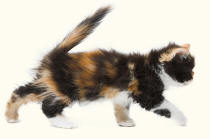Glossary

Walk
The slowest of all gaits used by cats and dogs, in which minimum energy is expended.
Three limbs remain on the ground while the fourth is raised and moved forwards.
Three limbs remain on the ground while the fourth is raised and moved forwards.
Amble
A symmetrical, relaxed gait between the walk and the trot, in which the ipsilateral limbs move (almost) in unison.
However, the hind limb is raised very slightly earlier, and lands slightly earlier, than the forelimb.
However, the hind limb is raised very slightly earlier, and lands slightly earlier, than the forelimb.
Pace
A symmetrical, relaxed gait between the walk and the trot, in which ipsilateral limbs move in unison.
Weight is transferred from one side to the other, usually resulting in a rolling motion of the body. It offers faster speed than the walk but expends less energy than a trot.
Weight is transferred from one side to the other, usually resulting in a rolling motion of the body. It offers faster speed than the walk but expends less energy than a trot.
Trot
A symmetrical, two-beat gait in which diagonally contralateral limbs move in unison.
This is an endurance gait, which allows coverage of ground at a reasonable speed but without expending maximum energy. The trot may, therefore, be maintained for hours.
This is an endurance gait, which allows coverage of ground at a reasonable speed but without expending maximum energy. The trot may, therefore, be maintained for hours.
Canter
An asymmetrical, three-beat gait in which two diagonally contralateral limbs are moved in unison, and the other two are moved separately.
This movement provides more speed than a trot, without the expenditure of energy of a (suspended) gallop. It is not often adopted by dogs or cats.
This movement provides more speed than a trot, without the expenditure of energy of a (suspended) gallop. It is not often adopted by dogs or cats.
Gallop
The fastest gait of an animal, in which all four feet are off the ground during the stride.
There are two kinds of gallop: the supported gallop (more usually know as the canter) and the suspended gallop.
There are two kinds of gallop: the supported gallop (more usually know as the canter) and the suspended gallop.
Breed Standard
A written standard that lists the attributes that are desirable in a breed of cat or dog created by breed associations and clubs, and standardized and approved by governing bodies.
This provides a blueprint for breeders and judges of conformation shows.
This provides a blueprint for breeders and judges of conformation shows.
Title8
text
Title9
text
hover over shaded words to reveal more
Gait
The pattern of movement of animals during (terrestrial) locomotion.
Gaits used by cats and dogs include the walk, the amble, the pace, the trot, the canter and the gallop.
Some dog breed standards describe those gaits that are desirable and those that are not. The breed standards of cats do not refer to gaits. However, terms that are applied to dogs are equally applicable to cats.

Hungarian Vizsla, Weimaraner and Pointer





